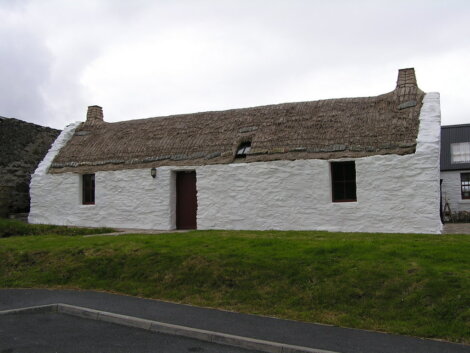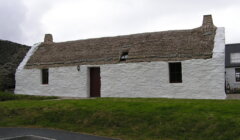History / Removal of A-listed building’s thatched roof given go-ahead
PLANNING permission has been granted for temporarily removing the thatched roof covering at a historic crofthouse in Burra.
The hope is that temporarily replacing the roof covering at the A-listed Easthouse would halt water ingress while also buy time to consider the longer-term future of thatching in Shetland.
Shetland Islands Council’s planning service ruled that although the proposed alterations would have a “detrimental impact” on the special interest of the listed building, this would be balanced by “making the building weathertight and facilitating its ongoing viable use whilst suitable replacement thatching material is sourced”.
The historic croft house in Papil has been owned by the Burra History Group since 2006, and it acts as a heritage centre which opens to the public during the summer. It also features a barn, byre, pigsty and henhouse.
The A-listed crofthouse dates back to the mid 19th and early 20th century.
But its condition – exacerbated by the weather and primarily related to the deteriorating thatch roof – means it has not opened this summer to the public, and the history group itself has had to use alternative premises.
The history group’s Adalene Fullerton previously said a key problem is a change in climate – the prevailing wind used to be from the west, but is now from the east.
A feasibility study had been prepared by Malcolmson Architects to look at the options for the building’s future.
It had resulted in a planning application for the removal of the thatch and installation of new rafters plus a temporary metal sheeting roof, as well as replacement windows.
The study reiterated that weather has ultimately taken its toll on the building.
It added that the history group now encounters “serious problems caused by the burden and difficulties of annual maintenance, persistent water ingress, damage to both the building fabric and its contents, and ever-increasing running costs”.
Become a member of Shetland News
“The scale of the problem, largely caused by the deteriorating thatch roof, now means that the level of maintenance required has become untenable.”
One particular problem was said to be the lack of local skills and materials for annual repairs and re-roofing.
By 2019 the crofthouse was only one of five buildings, or groups of buildings, known in Shetland to have an intact thatched roof – another being the Crofthouse Museum in the South Mainland, which is run by Shetland Amenity Trust.
The roof at Easthouse is a replica using traditional Shetland thatching techniques.
The building was repaired and restored between 2001 and 2006 using traditional materials where possible, and the process was even featured on a national BBC TV show.
It was lived in permanently until 1972 before it was occupied by oil terminal construction workers and then holidaymakers until the 1980s, and then it was empty prior to the history group taking it on.
Consultations on the property’s future were held with Historic Environment Scotland, Shetland Amenity Trust and Shetland Islands Council.
Four options were created off the back of these meetings, including replacing the thatch with a permanent roof covering. However the preferred option was a five-year temporary solution where only the straw covering is removed and a new waterproof “hat” is constructed to protect the building.
It is said this would allow time for heritage organisations to develop a long-term strategy for sourcing traditional thatching materials and training craftsmen.
It would also allow the history group to continue to use the building without concerns over water leaks and damage.
Become a member of Shetland News
Shetland News is asking its many readers to consider paying for membership to get additional features and services: -
- Remove non-local ads;
- Bookmark posts to read later;
- Exclusive curated weekly newsletter;
- Hide membership messages;
- Comments open for discussion.
If you appreciate what we do and feel strongly about impartial local journalism, then please become a member of Shetland News by either making a single payment, or setting up a monthly, quarterly or yearly subscription.





























































